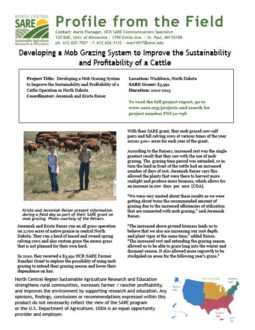Jeremiah and Krista Reiser run an all grass operation on 2,700 acres of native prairie in central North Dakota. They run a herd of leased and owned spring calving cows and also custom graze the excess grass that is not planned for their own herd.
In 2010, they received a $5,991 NCR-SARE Farmer Rancher Grant to explore the possibility of using mob grazing to extend their grazing season and lower their dependence on hay.
With their SARE grant, they mob grazed cow-calf pairs and fall calving cows at various times of the year across 300+ acres for each year of the grant.
According to the Reisers, increased rest was the single greatest result that they saw with the use of mob grazing. The grazing time period was extended, so in turn the land in front of the cattle had an increased number of days of rest. Jeremiah Reiser says this allowed the plants that were there to harvest more sunlight and produce more biomass, which allows for an increase in cow days per acre (CDA)
“We were very excited about these results as we were getting about twice the recommended amount of grazing due to the increased efficiencies of utilization that are connected with mob grazing,” said Jeremiah Reiser.
“The increased above ground biomass leads us to believe that we also are increasing our root depth and plant vigor at the same time,” added Reiser. “The increased rest and extending the grazing season allowed us to be able to graze long into the winter and dormant season. It also allowed more regrowth to be stockpiled on areas for the following year’s graze.”
View Jeremiah and Krista's presentation on this project, from the 2015 Farmers Forum, through NCR-SARE's YouTube playlist. Visit www.youtube.com/NCRSAREvideo for this and other videos.
